Rainbow Plateau | Mongollon Rim | Mexico's Copper Canyon | Europe | Canyons of Mars | Crystal Caves | Canyonland Books
Fertilizer that is natural, organic and originates from abundant wild plants and algae was grown and harvested in ancient civilizations that built pyramids and monumental architecture in Cambodia's Angkor Empire, Egypt, Aztec, Maya, Anasazi, Hohokam, Tiwanaku Bolivia as well. These seven ancient civilizations all used variously Azolla, Cynobacteria, Legumes, Blue Green Algae, EM, Cryptobiotic soils, and Mesquite to provide fertilizer for ample rice, wheat and corn crops. These crops provided the calories to build a large population base and there after pyramids and monumental architecture.
Ancient Fertilizer
Built Monumental Pyramids of
Cambodia • Egypt • Maya • Aztec

by Richard D. Fisher
© June 12, 2013
Ancient monumental architecture required ancient fertilizer in the Khmer Empire of Angkor, as well as built the pyramids of Egypt and the Mayan/Aztec,and provided the fertility resources for the Chaco Canyon and other Anasazi/Hohokam to inhabit their home territory for several hundred years or more. It is well known that most of these monumental building projects took well defined, if not massive, irrigation systems. What is not recognized at all, is that these engineered water containment structures had a built in natural fertilizer collection and production system that focused on blue green algae. These water gathering irrigation systems collected naturally produced fertilizers from forest and cryptobiotic plains. Additionally, the blue green algae naturally grows in the water collection basins which are, in some cases, designed to dehydrate the algae which could then, by weight and volume, be relatively easy to transport.
In the Khmer of Cambodia and the Pyramid builders of Egypt the granulated and powdered fertilizer could be easily transported in it’s dry state over long distances by oxcart. In the case of the Mayan/Aztecs and the Anasazi/Hohokam in load bearing baskets carried by humans. This system of collection and production of ancient fertilizers is the key to understanding the agricultural basis for numerically large populations that are required to build monumental architecture in the late stone age among the Anasazi/Hohokam, early bronze age of the Mayan/Aztec, and in the case of the Khmer Civilization, the early iron age.
I have made a effort here to provide a detailed scientific presentation of natural aquatic and forest fertilizers plants that built monumental architecture as well as material that the lay reader can enjoy and learn from concerning the Angkor Civilization of Cambodia.
The beauty as well as productivity of aquatic environments key to sustainable agriculture.

Ancient Fertilizer
= Monumental Architecture
Grand
Canyon of Cambodia
Mysterious Source of Fertile Waters for the Angkor Khmer Civilization and Empire
The fertilizer that created Khmer empire and civilization is a mystery to scientist today but the Khmers of then and now well understood well the source of this fertility. As the Siem Reap river feeds this fertility down to the Khmer capital through what we call the "Grand Canyon of Cambodia" to be further enhanced this web site will focus on this mysterious resource of fertility that also built the ancient Egyptian, Mayan, Aztec, Anasazi and Hohokam civilizations among others during the late stone age and early bronze age.
The Khmer empire best know for building Angkor Wat existed for just over 500 years from 800-1431 and was built on and by a mysterious agricultural system that used a currently unrecognized fertilizer strategy to feed it's workers, armies, as well as Kings and their vast courts housed in some of the largest buildings constructed before the industrial revolution. In the end it was not drought or environmental disaster that destroyed the civilization but and invasion by their former allies, the Thai empire to the west, who are said to have been under pressure from the Mongal Empire centered in China at that time.
The Khmers are said to have built the worlds first megacity of over 1 million people and a mysterious agricultural system that was successful in feeding the general population along with thousands of skilled builders as well as vast armies of farmers cum soldiers and an attendant "navy" as well.
What is now considered the center of the empire is near the modern city Siem Reap Cambodia at the ancient site of Angkor Wat designated one of the seven wonders of the world.
Photographically this web chapter will provided a number of stunning photographs of major sites such as Angkor Wat, Angkor Thom, Ta Prohm, Boeng Mealea, Bantheay Srei, and the sacred Mount Kulen, now a national park and the headwaters of the Siem Reap River. This mountain and river along with the Tonle Sap Lake provided the fertility feed more than one million residents of the capital of the Khmer empire as well as hundreds of thousands residing in outlaying cities, town and villages.
While the photography will feature the famously splendid architecture the text will present and entirely new view of Khmer agriculture and the relationship similar to the ancient knowledge of the Mayan, Aztec, Anasazi as well as Egyptian civilizations.
It has been said that the vast building and reservoir system has "no practical use and is entirely unfamiliar and strange to the 21st century." This may be precisely true but to those knowledgable of "natural systems" as applied to the late stone and early bronze age of human cultural evolution the enigma can be fully resolved thru a new understanding of fertility management and control of that time period.

Map of the West Baray Siem Reap Cambodia. There are many theories about the reasons for the massive construction of the West Baray.
I add a new theory, that it is for the production of water grown aquatic plants used fertilizer as well as animal and human food.
It might also
have accommodated crocodile production as well as an
elephant maintenance area which are both compatible
with the
growth of aquatic fertilizer. View of the West Baray for the Siem
Reap balloon tourist attraction. November 2012
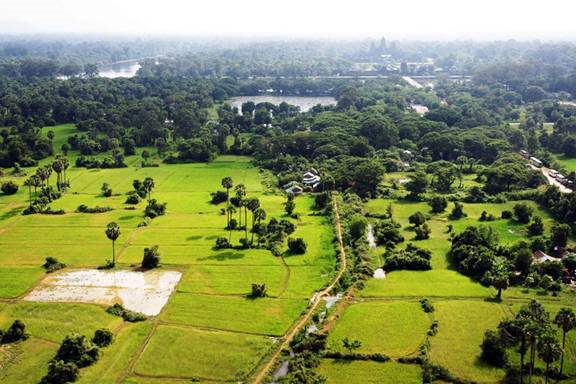
Angkor_agriculture_Cambodia.jpg
View of the Angkor Wat Temple over the agriculture fields today much
as it might have been at the height of the Khmer Empire.
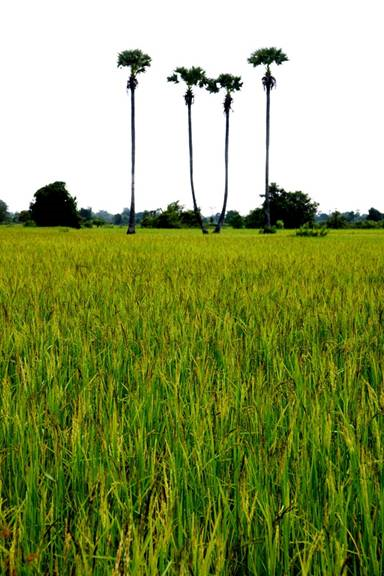
Cambodia_fertile_rice.jpg
"A well fertilized field is happiness" old Chinese proverb applies to
agriculturalist world wide. Above and below.

Cambodia_baray_temple_island.jpg
Exploring the restoration in progress on the temple island in the middle of the West Baray. December 2012

Lijaing Yunnan
China is the only place where I have been able to observe the local
farmers actually scraping
the upland forest floor to obtain fully
natural EM fertilizer. Here is what it looks like up close for
growing corn, above.

This is one of the shrine rooms to fertilizer of which there are hundreds or perhaps even thousands from the Khmer Empire.
EM
Microorganisms are often used in organic agriculture, as they are useful for eliminating problems associated with chemical fertilizers and pesticides (Higa, 1991; Parr et al 1994 cited in Higa and Parr, 1994). A microbial culture named "Effective Microorganisms" (EM) was developed by Professor Teruo Higa of the University of Ryukyus, Japan after he began his EM technology research in 1984, with the purpose of improving soil quality, soil health, and the growth, yield and quality of plants (Higa and Parr, 1994).
EM consists of around 80 species of selected beneficial microorganisms including lactic acid bacteria, yeasts, photosynthetic bacteria, and actinomycetes, among other types of microorganisms such as fungi (Xu, 2000). These produce a wide range of benefits arising from the increased microbial diversity in the soil as well as the individual effects of the particular types of microorganisms. Benefits to soil and plant health include the fixation of atmospheric Nitrogen, decomposition of organic wastes and residues, suppression of soil borne pathogens, and the increased availability of plant nutrients (Higa and Parr, 1994). It has been shown that the application of EM can improve photosynthetic efficiency and capacity due to an increase in nutrient availability, as well as increase root mass (Fujita et al., 1997 cited in Yamada and Xu, 2000).
Ancient Fertilizer Plants grown and used in modern Cambodia
kompign Poy
(A kind of aquatic creeping herb with red or white flowers, used for fertilizer, feeding people, buffalo and pigs)
Tra kiet (An edible aquatic plant for Buffalo and people)
Trakoun (water convolvulus, food for people and animals)
Slab Chhrova (An edible aquatic grass, having paddle shaped leaves)
EM, 1- one liter + 500 liter of water (for water vegetable)
information courtesy of Mr. Peou Kanh
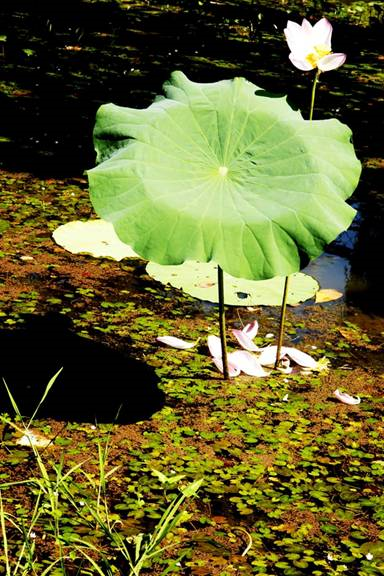
Water grown plants for fertilizer as well as
human and animal food.

Animals, humans and plants yoked together by water to produce the fertilizer needed to feed hundreds of thousands people who built the Khmer Monumental Architecture over hundreds of years of intensive agriculture in one localized region.

Analyzing modern irrigation structures relating to the West Baray, modern Angkor Cambodia. Today it requires massive
and strong concrete structures to control the waters of the West Baray. I propose that the Khmer engineers used "Pit Valves"
carved in solid stone and that the outlets were situated safely in the middle of the Barays not on the edges
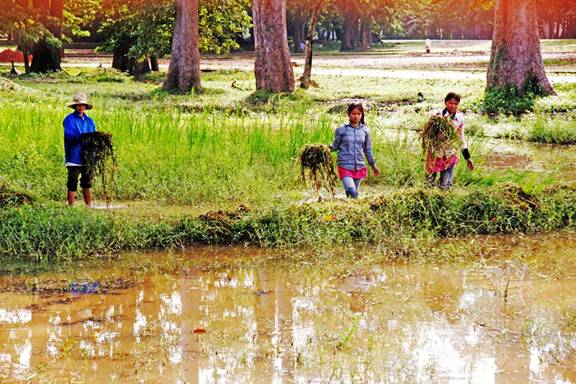
Ancient_Fertilizer_harvest_Cambodia.jpg
A view of fertilizer harvest much as it was hundreds of year ago in the Angkor Empire of Cambodia past and and now in the present. (above and below)

Azolla and Rice Productivity
Rice is the single most important source of food for people and Azolla plays a very important role in rice production. For centuries Azolla and its nitrogen-fixing partner, Anabaena, have been used as "green manure" in China, Cambodia and other Asian countries to fertilize rice paddies and increase production. Some authorities believe the use of Azolla enabled the Vietnamese to survive the effects of the American blockade when imported fertilizers did not reach North Vietnam during the war. According to Wilson Clark (Science 80: Sept./Oct. 1980), the People's Republic of China has 3.2 million acres of rice paddies planted with Azolla. This provides at least 100,000 tons of nitrogen fertilizer per year worth more than $50 million annually. Extensive propagation research is being conducted in China to produce new varieties of Azolla that will flourish under different climatic and seasonal conditions. According to some reports, Azolla can increase rice yields as much as 158 percent per year. Rice can be grown year after year, several crops a year, with little or no decline in productivity; hence no rotation of crops is necessary.
In addition to nitrogen fixation, Azolla has a number of other uses. Several California aquafarms grow Azolla in large vats of circulating fresh water. Apparently fish and shrimp relish the Azolla. In fact, Azolla was grown for fish food and water purification at the Biospere II project in Arizona (a 2.5 acre glass enclosure simulating an outer space greenhouse). FreshAzolla and duckweed (Wolffia) can also be used in salads and sandwiches, just as alfalfa and bean sprouts are used. Dried, powdered Wolffia and Azolla make a nutritious, high protein powder similar to the popular alga (cyanobacterium) Spirulinathat is sold in natural food stores. Azolla has also proved useful in the biological control of mosquitos. The mosquito larvae are unable to come up for air because of the dense layer of Azolla on the water surface. Azolla grows very quickly in ponds and buckets, and in makes an excellent fertilizer (green manure) and garden mulch.

It is estimated
that 40,000 people lived in the Angkor Wat Temple at it's peak. That would be
an estimated
production of more than a ton of "night soil" or
human fertilizer per day. The arrow in the above map
shows
where the "mixing bowl" might have been before the fertile
waters entered the West Baray.
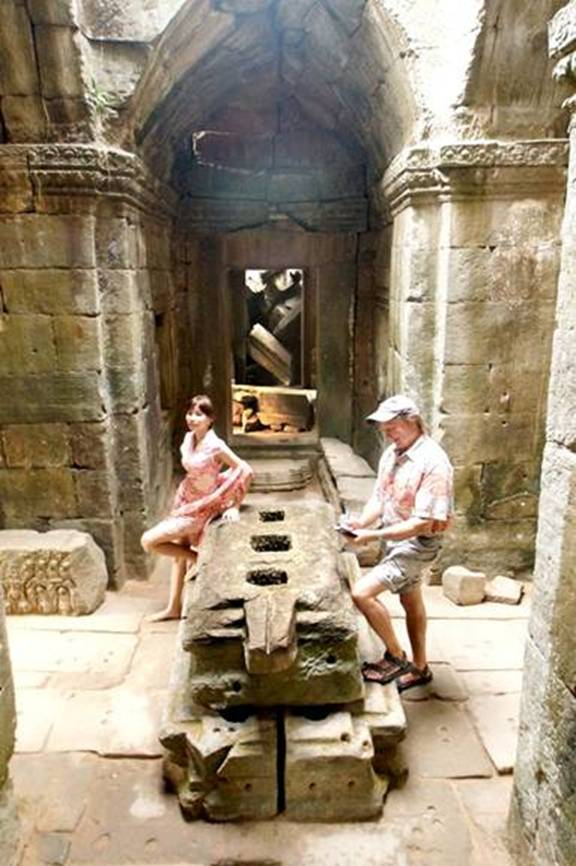
Richard D Fisher investigative journalist.
Female carved stone alter and perhaps water control devise of as yet undetermined usage?
Only a symbolic religious stone carving or does this have a practical use as well?
Research on this device will continue in 2013-2014
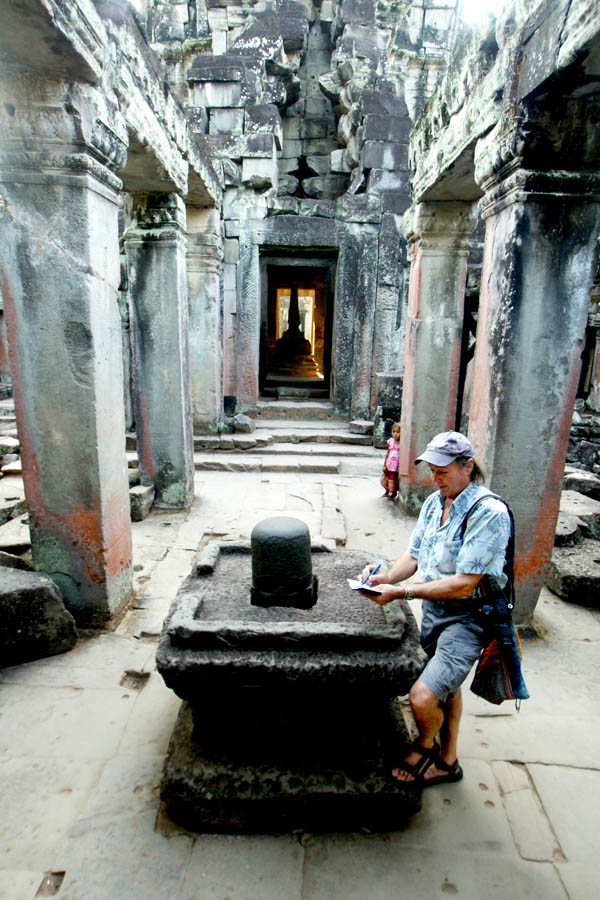
As this "Yoni"
base is carved from one piece of solid stone, this device would
be very stable under
tons of water pressure. This would also be true for the
"stopper"linga. Certainly this could very well be
a water control
device and a Hindu religious representation of spiritual power at the
same time.
"The powerful spiritual device used to feed hundreds of thousands of people and build an empire."
Richard D. Fisher investigates March-April 2013
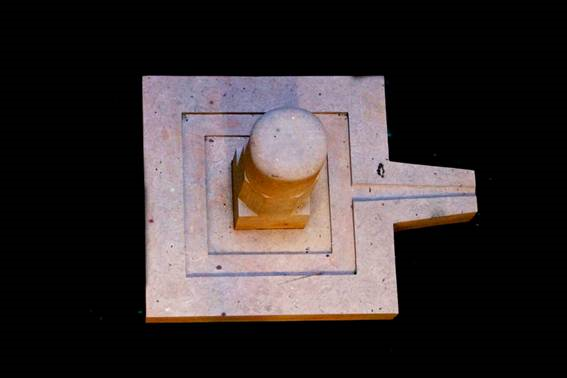
Look closely at this reproduction of the Yoni-Linga and note the square and hexagonal
feature at the base. Clearly this could very well be a mechanical device for controlling
water called a "pit valve." The square and hexagonal feature could both easily be fitted to
wooden, iron or bronze wrenches as a mechanical turning devise. Under tremendous
water pressure it could have needed to be a 2 man operation?
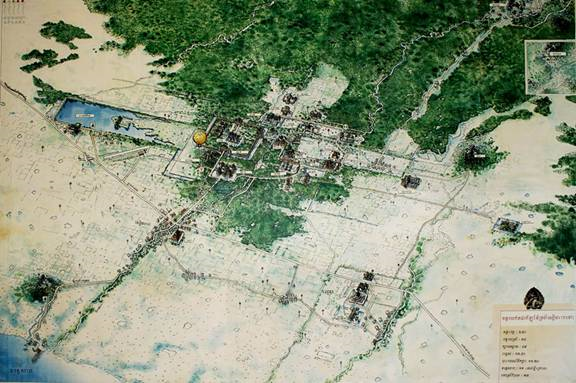
Monumental Architecture floating on hydrostatic pressure. One of the most fascinating discoveries
is the the temples have no foundations but rather a basis of wet sand. For the temples to remain standing
the sand foundation has to be kept wet. That is one of the reasons for all the water works at Angkor, to keep
the water table just at the base of the temples. In other words the entire complex is "floating" on hydrostatic pressure.
Ancient knowledge that has been "lost" and been rediscovered by the modern Cambodian elite themselves.
This was explained to me by Dr. Peou Hang the modern controller of the Ankor water works.
Analysis and discussion of naturally produced plant Ancient Fertilizer.
Microorganisms that fix nitrogen called "diazotrophs."
Diazotroph
Cyanobacteria, e.g. the highly significant Trichodesmium
Green sulfur bacteria
Azotobacteraceae
Rhizobia
Frankia
Nitrogen fixation by Frankia
Frankia, Gram-positive soil bacteria, induce the formation of nitrogen-fixing nodules in actinorhizal plants.
Nitrogen fixation by cyanobacteria
Cyanobacteria inhabit nearly all illuminated environments on Earth and play key roles in the carbon and nitrogen cycle of the biosphere. In general, cyanobacteria are able to utilize a variety of inorganic and organic sources of combined nitrogen, like nitrate, nitrite, ammonium, urea, or some [[amino acids]]. Several cyanobacterial strains are also capable of diazotrophic growth, an ability that may have been present in their last common ancestor in the Archaean.[4] Nitrogen fixation by cyanobacteria in coral reefs can fix twice the amount of nitrogen than on land—around 1.8 kg of nitrogen is fixed per hectare per day. The colonial marine cyanobacterium Trichodesmium is thought to fix nitrogen on such a scale that it accounts for almost half of the nitrogen-fixation in marine systems on a global scale.[5]
Root nodule symbioses
Legume family
Plants that contribute to nitrogen fixation include the legume family – Fabaceae – with taxa such as kudzu, clovers, soybeans, alfalfa, lupines, peanuts, and rooibos. They contain symbiotic bacteria called Rhizobia within nodules in their root systems, producing nitrogen compounds that help the plant to grow and compete with other plants. When the plant dies, the fixed nitrogen is released, making it available to other plants and this helps to fertilize the soil.[1][6] The great majority of legumes have this association, but a few genera (e.g., Styphnolobium) do not. In many traditional and organic farming practices, fields are rotated through various types of crops, which usually includes one consisting mainly or entirely of clover or buckwheat (non-legume family Polygonaceae), which are often referred to as "green manure". Inga alley farming relies on the leguminous genus Inga, a small tropical, tough-leaved, nitrogen-fixing tree.[7]
Non-leguminous
Although by far the majority of plants able to form nitrogen-fixing root nodules are in the legume family Fabaceae, there are a few exceptions:
· Parasponia, a tropical Celtidaceae also able to interact with rhizobia and form nitrogen-fixing nodules[8]
· Actinorhizal plants such as alder and bayberry, can also form nitrogen-fixing nodules, thanks to a symbiotic association with Frankia bacteria. These plants belong to 25 genera[9] distributed among 8 plant families. The ability to fix nitrogen is far from universally present in these families. For instance, of 122 genera in the Rosaceae, only 4 genera are capable of fixing nitrogen. All these families belong to the orders Cucurbitales, Fagales, and Rosales, which together with the Fabales form a clade of eurosids. In this clade, Fabales were the first lineage to branch off; thus, the ability to fix nitrogen may beplesiomorphic and subsequently lost in most descendants of the original nitrogen-fixing plant; however, it may be that the basic genetic andphysiological requirements were present in an incipient state in the last common ancestors of all these plants, but only evolved to full function in some of them:
http://en.wikipedia.org/wiki/Nitrogen_fixation

Related to the King - Hindu God Vishnu
Carved into the stone on the head waters of the Siem Reap River and the bust of a bronze statue escalated on the
Mebon Temple Island in the West Baray. I propose this is connecting the fertility of the legume jungle forested river headwaters
with the fertilizer producing function of the West Baray and that the ancient Khmer people knew of this connection.

This "pit valve"
was excavated in the middle of the West Baray on the artificial Melbon
Temple Island. Discovered and illustrated by French
authority on Angkor,
Jacques Dumarcay. I made every strenuous effort to
contact Msr. Dumarcay but as he is retired he apparently cannot be
contacted. My highest respects to Jacques Dumarcay for this discovery,
a great key to understanding the key water
control systems of Angkor.

A "pit valve" by any other name. Clearly a water control device in this formal architectural
rendering that is as yet unidentified. It functions like a very precise stopper in a bathtub.
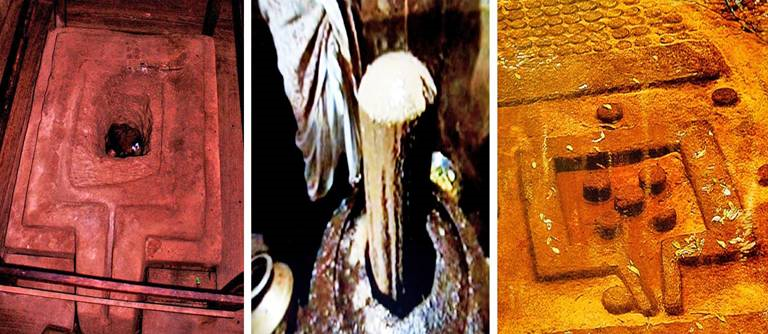
The universal male and female symbol in religious temples as well as carved under the life giving fertile waters.
Through the Khmer
carved into stone spiritual beliefs there is no mistaking their message,
fertility built their empire
and their spiritual power built
their temples.
Polytheistic vs
Monotheistic Religions and
Ancient Knowledge that built
Monumental Architecture
The Khmer, Egypten, Mayan/Aztec and Anasazi/Hohokam were all Polytheistic religions at the time the Monumental Architecture was built.
Food for thought and consideration. Although I have never heard or read this, I propose that the multiple gods of these ancient civilizations represent the powers of nature and men that were self evident to these early brilliant engineers.
These powers were observable and expressed as personalities of individual gods. I bring this up as at Angkor there appears there might be a connection of the downfall of Khmer civilization when Buddhism, a monotheistic religion became the dominate political force and replaced the natural gods of nature and there for the ancient knowledge of how to control natural processes like fertilizer production from plants on a massive scale and to also control the distribution of these fertilizing waters.
It has been suggested to me by Dr. Peou Hang of the modern Water Control Department at Angkor that perhaps the knowledge of controlling the waters was lost for the reason that the Hindu priest engineers left the area or were perhaps eliminated or in any case lost power to control the waters. Dr. Peou Hang told me, "when you control the waters, you have everything."
Polytheism (poly- meaning many and -theism meaning belief in a god) or the practice of worshipping many gods, does not occur in many of the dominant modern religions (Christianity, Islam, Buddhism, etc...) You can tell a lot about a society by looking at its religion.
Monotheism (mono- meaning one and -theism meaning the belief in a god) started much later than polytheism. The Jews could be considered the founders of this monotheistic idea, although there were a few instances of such religions in previous times. Christianity, Islam, and Buddhism are all monotheistic religions. Some people consider Hinduism to be a polytheistic religion. Throughout history, people had accepted the idea that many gods (natural forces) ruled, but a group of people came up with the revolutionary idea that there was only one god and that this one God was omnipresent (all present), omnipotent (all powerful), and omniscient (all knowing).
Again it should be considered that this is the time period where the ancient knowledge of natural fertility that built the pyramids of Cambodia, Egypt and the Maya/Aztec was lost.
Although inscriptions at Angkor are relatively rare it is know that the names of individual rice farmers, like an "honor roll", have been found carved into stone. This indicates the high status and recognition of the key roll that farmers played in the Khmer Civilization.
Discussion of Hindu Beliefs Relating to this Engineered Water Control at Angkor
In Hindu thought, the relationship between Brahma, Vishnu and Shiva is the natural functioning of the universe, life as we know it, and there is no friction between them because they function as they should as one entity. These three principles function life and the three personified principles are one eternal Divine principle responsible for all that is. However, in Hinduism, there are Vaishnavites who worship Vishnu as Supreme Lord and Savites who worship Shiva as Supreme Lord. Two notable avatars (incarnations) of Vishnu are Sri Krishna and Buddha. Lord Ganesha is the elephant headed son of Shiva.
In closing, on the absolute scale, within the totality of existence, the manifest consciousness, the constant cycle of birth, life and death transpires each moment and the functioning of Brahma, Vishnu and Shiva is the fomless, immutable reality underlying and pervading the ephemeral universe.
Rudra and Agni have a close relationship. ... Both are associated with mountains, rivers, male fertility, fierceness, fearlessness, warfare, ... It consists of the worship of Shiva and Vishnu
Shiva --- Linga + Yoni
The Khmer or Angkor Civilization came into existence during the period from 802 to 1431 A.D. and stretched as far as the modern Thailand-Burma Border in the West and Wat Phou of Laos in the North during its peak.
Its emergence lies in the fact that the ancient Khmer rulers adopted a right political doctrine of its time, which enforce the unity among people. Moreover, they had developed an intelligent irrigation system to control the water of the great Mekong River for agricultures, which enhanced its prosperity. The Khmer Civilization had long been perished over 5 centuries ago, but it left outstanding monuments such as the great Khmer temples of Angkor Wat and Bayon and numerous unique sculptures like Apsara.
The word "Angkor" is derived Sanskrit, an ancient Indian language, of "Nagara" which means "City". Angkor Wat literally means "City of Temple" and Angkor Thom "The Magnificent City".
No doubts, the ancient Khmers were great masters of stone carving. As we can see today the unarguable evidences of various Angkor temples lying on the vast plain of Siemreap, or even beyond its present-day border to the Preah Vihear at Dangrek Mountain, Phnomrung and Phimai in Thailand and Wat Phu in Laos. All these were created and carefully crafts by the ancient Khmers in successive centuries. This seems to contradict with the normal and easy-going life of the local Khmer people and villagers of their time. What drive them to put such an extraordinary efforts and time will be explained in the next chapters.
The study of Khmer civilization in depth is not easy and pain-taking by the historians and archaeologists. Most of the writing, found after the excavation of Angkor, were carved in the stones which became the unperishable materials against time. Although these evidences are important for us to understand the basic constituency of Khmer society and its chronology, they were mainly concerned with religious rituals, King's praise, and literature of Indian epics of "Ramayana" and "Mahabharata". There were little things saying about the ordinary life of the local people.
Interestingly, we learn about the daily way of life of the ancient Khmers, not from the Khmer themselves, but from the Chinese annals. In the middle of 13th century during Chinese Yuan Dynasty, a Chinese ambassador named Zhou Daguan traveled to Angkor, stayed with the local villagers, and explored this empire for a year before his return. He wrote in his Chinese chronicle about this amazing empire, and explain vividly how the people lives with the clear portrayal of the Khmer society during those days.
The center of the Khmer Civilization is at the Angkor Wat area which is situated on the plain of present-day Siemreap province north of the Great Lake of Tonle Sap. Throughout the course of Khmer history, the kingship was frequently attained by violent means with bloodshed throne. There were successive capitals built by different kings in the region, not far from each others; these capitals are at area of Angkor Wat and Roluos with the different names such as Harihalara, Yasodharapura, Jayendanagari, Angkor Thom and a few unknown names.
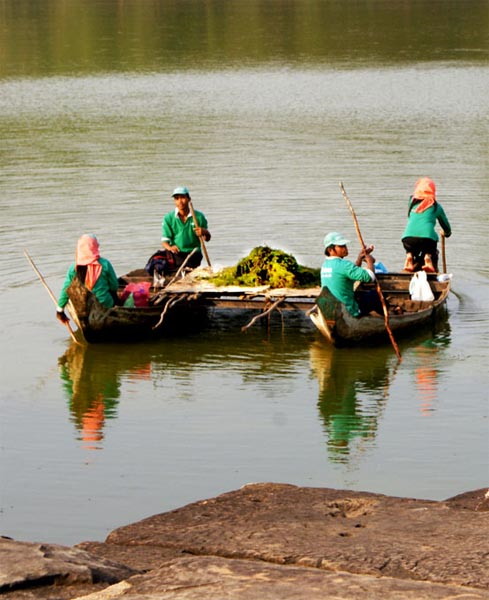
Agricultural fertility reality as well as religious symbolism unified in Hindu life ways and spiritual beliefs.
The Hindu creation myth Churning the Sea of Milk is shown in the bas-relief panel at the East gallery (panel 4) of Angkor Wat.
In the boat green fertilizer Azolla is "harvested from the Angkor Wat moat.
Azolla Uses: A. pinnata R. Br.: The plant is used as a green manure because of the nitrogen fixing blue-green algae (which contain 3% N) in the leaves; It is used in wet rice fields to enhance yields and it also restricts the growth of Cyperus difformis and Echinochloa spp.; The plant is rich in protein and is given to cattle and poultry.

Banteay Srei Angkor
It seems there are some very mysterious and large water features (West Baray) which have no outflow like those in the Maya, Aztec, Anasazi, and Hohokam civilizations/cultures. In Angkor a solution to a world wide archaeological mystery.
Trees of the fertile waters of the Angkorean Civilization of the Khmer Empire and the key to the agricultural fertility leading to the longevity of successful massive building projects over 500 years.
Green manures usually perform multiple functions, that include soil improvement and soil protection:
Leguminous green manures such as clover and vetch contain nitrogen-fixing symbiotic bacteria in root nodules that fix atmospheric nitrogen in a form that plants can use.
Green manures increase the percentage of organic matter (biomass) in the soil, thereby improving water retention, aeration, and other soil characteristics.
The root systems of some varieties of green manure grow deep in the soil and bring up nutrient resources unavailable to shallower-rooted crops.
Some green manure crops, when allowed to flower, provide forage for pollinating insects.
Incorporation of cover crops into the soil is immediately followed by an increase in abundance of soil microorganisms that aid in the decomposition of this fresh material. The degradation of plant material allows the nutrients held within the green manure to be released and made available to the succeeding crop. This additional decomposition also allows for the re-incorporation of nutrients that are found in the soil on a particular farm such as nitrogen (N), potassium (K), phosphorus (P), calcium (Ca), magnesium (Mg), and sulfur (S).
Microbial activity in the soil also leads to the formation of mycelium and viscous materials which benefit the health of the soil by increasing its soil structure (i.e. by aggregation)[1]. Soil that is well- aggregated has increased aeration and water infiltration rates, and is more easily turned or tilled than non- aggregated soil. Further aeration of the soil results from the ability of the root systems of many green manure crops to efficiently penetrate compact soils. The amount of humus found in the soil also increases with higher rates of decomposition, which is beneficial for the growth of the crop succeeding the green manure crop.
Green manure crops are also useful for weed control, erosion prevention, and reduction of insect pests and diseases. The deep rooting properties of many green manure crops make them efficient at suppressing weeds[2]. Green manure crops often provide habitat for many native pollinators as well as predatory beneficial insects, which allow for a reduction in the input of insecticides where cover crops are planted. Some green manures are also successful at suppressing plant diseases, especially Verticillium wilt in potato[3]. Incorporation of green manures into a farming system can drastically reduce, if not eliminate, the need for additional products such as supplemental fertilizers and pesticides.
Green Manure Crops
Another important contribution of green manure to an agricultural field is the nitrogen fixing ability and consequent nitrogen accumulation in the soil, particularly of those leguminous crops used. Depending on the species of cover crop grown, the amount of nitrogen released into the soil lies between 40 and 200 pounds per acre. With green manure use, the amount of nitrogen that is available to the succeeding crop is usually in the range of 40-60% of the total amount of nitrogen that is contained within the green manure crop[1].
Nitrogen Fixation
Many Legumes are able to convert atmospheric nitrogen into nitrogenous compounds useful to plants. This is achieved by the presence of
n root nodules (which are visible to the naked eye) containing bacteria of the genus Rhizobium. These bacteria have a symbiotic relationship with Legumes, fixing free nitrogen for the plants. In return legumes supply the bacteria with a source of fixed carbon produced by photosynthesis. This enables many Legumes to survive and compete effectively in nitrogen poor conditions.
Root nodules are general in the Mimosoideae and Papilionoideae, but rarely formed in the Caesalpinioideae.
Brother Number One
A failed agricultural and social experiment 1975-1979 based on bad European ideas that cost Cambodia much more than 2 million lives.
Pol Pot's ideas combined an idealization of the Angkor Empire (802–1431), with an existential fear for the existence of the Cambodian state, which had historically been liquidated under Vietnamese and Siamese intervention. Their ideology was also influenced by colonial French education, which posited Khmers as "Aryans among Asians", who were morally superior and that rice agriculture was based on water only and no provision for fertilizer.
What Brother Number One did not realize is that there were several other European misconceptions about the Khmer success. As he wanted to turn Cambodia into a rice growing copy of the Khmer Empire, he completely missed necessity for growing, in tropical climates, the fertilizer requirement for success. European agriculture in temperate climates is completely different than agriculture in the tropics. Therefore western scientist have missed the agricultural key to success, not only in the Khmer but also the Egyptian, Mayan/Aztec and Anasazi/Hohokam civilizations as well. There is currently a complete disconnect between agricultural and earth sciences and archaeology in the cases which are for the first time detailed here.
(in part from Wikipedia)
Entermorpha Alga as Fertilizer
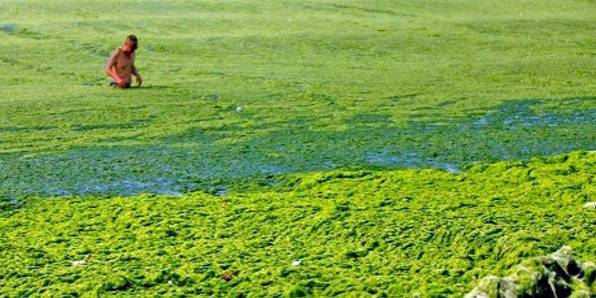
The Entermorpha alga fertilizer is rich in active substances of algae, not only can strengthen photosynthesis of crops, increase the yield of the crops and improve the product quality but also can strengthen the cold resistance, the drought resistance, the stress resistance and the disease resistance of the crops, promote earliness of the crops and increase the fertile flower percentage and the fertile fruit percentage, has lower production cost, good solubility and safe use, is friendly and harmless to human beings, domestic animals and the natural environment, and is a novel (I would say Ancient) environment-friendly fertilizer suitable for modern agriculture.
Maya/Aztec
Photography © Daniel
Maddux
Photoshop Art by Sunracer Photography 7/2013
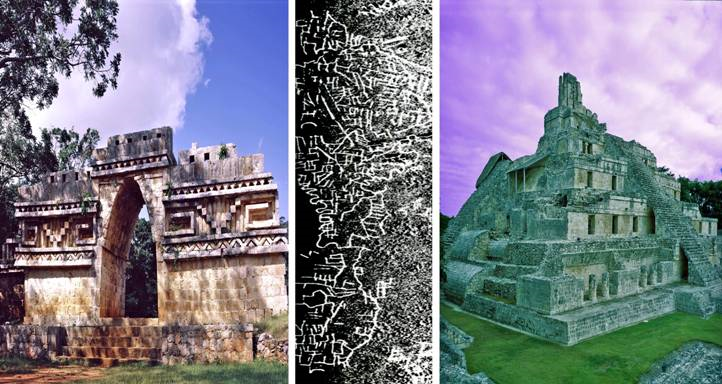
Mayan Arch and Temple sandwiching a radar photograph of the canal system the advanced Mayan Agriculture where the Maya grew "Periphyton" a complex mixture of algae, cyanobacteria, herterotrophic microbes and detritus that are attached to submerged surfaces in most aquatic ecosystems. In design this is very similar to the Aztec Chinampas and in function this shallow cannel system a tremendously efficient, and previously unknown, food production system.
The canal systems main crop? Blue green alga for fertilizer.
With this discovery a completely new understanding of Mayan agriculture allows of a revolutionary view of the Mayan genius. Previously they were credited with only primitive "slash and burn" agriculture which would not work sustainability of hundreds of years in the tropical climates of Central America.
When I started this research project in the mid-1990's I believed that scientist would find the answers to the fertilizer requirements of the Maya/Aztec civilizations by now, especially legume forest trees. Unfortunately little or nothing has been done to date that I can find. There is still a lot of work that needs to be done but this web site provides the clue of where to start.
The Mayans painted in great detail many of their revered and sacred plants on their ceramics and murals at San Bartolo. While these colorful paintings were of great importance to the Mayans, apparently this field of ethnobotany is little studied at the present time. At San Bartolo, they painted in precise detail the five sacred Mayan trees. Even though I have exhaustively researched this line of investigation, I have been unable to find the names or species of the five sacred trees. From my knowledge of Native American religion, these trees would have special powers such as producing foods, medicines, or in the case of natural fertilizers, one or two of them might be a legume? This is a fertile and productive area for future Mayan archaeological research, as it will give critical knowledge that will help answer the current agricultural mysteries about this ancient pyramid building civilization.
Aztec Chinampas - Floating Gardens used Periphyton dredged with lakebed sediments to fertilize their floating gardens.
Sometimes referred
to as "floating gardens," chinampas were artificial islands that
usually measured roughly 98 ft × 8.2 ft
(30 m
× 2.5 m). Chinampas were used by the ancient Aztec
Indians. The chinampas ranged from 300 ft × 15 ft (91 m
× 4.6 m) to 300 ft × 30 ft (91 m
× 9.1 m) They were created by staking out the shallow lake bed
and then fencing in the rectangle. The fenced-off area was then layered with
mud, lake sediment, and decaying vegetation, eventually bringing it above the
level of the lake. Chinampas were separated by channels wide enough for
a canoe to pass. These "islands" had very high crop yields with up to
four crops a year.
Tiwanaku •
Bolivia
300 - 1,000 C.E.
New Discovery June 20, 2013
Blue Green Algae Built Another Monumental Architecture Civilization
by Richard D. Fisher © 2013
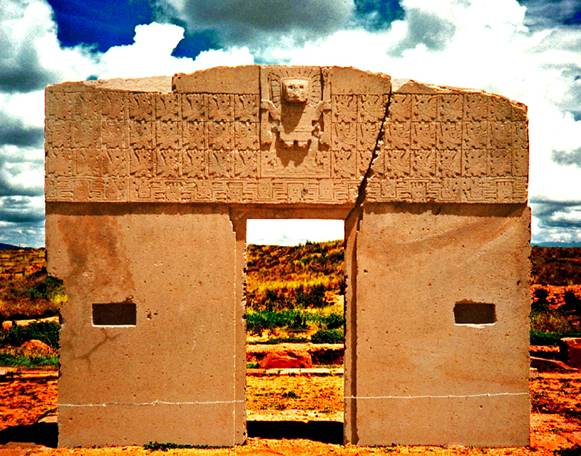
Tiwanaku - Gate of the Sun - Megalithic Stone Arch of Ancient Bolivian Civilization
When I was at Tiwanaku in the 1970's the dates could not yet be established for the site. Tiwanaku is in central Bolivia near the Southeastern shore of Lake Titicaca, South America. Today, I am still interested in Tiwanaku's age now that carbon dating has been done worldwide. I looked it up and I found this new science on the internet. The internet, with new science, is the way forward for freedom of research and publication especially concerning archaeology.
A new discovery concerning how blue green algae, agricultural production, population growth and Monumental Architecture related to each other step by step. (in green below)
I have highlight the area of interest to me. Also, these scientist have missed the central and critical usage of blue green algae to building Monumental Architecture of Tiwanku.
Now with Tiwanaku, I have now discovered 7 ancient cultures where Blue Green Algae was the foundation for agricultural which ultimately built Monumental Architecture for these civilizations. It will be interesting to see exactly how these simple microscopic plants are related, in all 7 cases, to these classic ancient civilizations and gigantic carved stone buildings.
From Wikipedia
The area around Tiwanak may have been inhabited as early as 1500 BC as a small agriculturally based village. Most research, though, is based around the Tiwanaku IV and V periods between AD 300 and AD 1000, during which Tiwanaku grew significantly in power. During the time period between 300 BC and AD 300 Tiwanaku is thought to have been a moral and cosmological center to which many people made pilgrimages.
The ideas of cosmological prestige are the precursors to Tiwanaku's powerful empire In 1945, Arthur Posnansky estimated that Tiwanaku dated to 15,000 BC using archaeoastronomical techniques. Later, as a result of the reevaluation of the techniques that Posnansky used to estimate the age of Tiwanaku, expert archaeoastronomical archaeologists concluded that they were invalid as they were a "sorry example of misused archaeoastronomical evidence.
Tiwanaku's location between the lake and dry highlands provided key resources of fish, wild birds, plants, and herding grounds for llamas. The Titicaca Basin is the most productive environment in the area with predictable and abundant rainfall, which the Tiwanaku culture learned to harness and use in their farming. As one goes further east, the Altiplano is an area of very dry arid land. The high altitude Titicaca Basin required the development of a distinctive farming technique known as "flooded-raised field" agriculture (suka kollus). They comprised a significant percentage of the agriculture in the region, along with irrigated fields, pasture, terraced fields and qochas (artificial ponds) farming. Artificially raised planting mounds are separated by shallow canals filled with water. The canals supply moisture for growing crops, but they also absorb heat from solar radiation during the day. This heat is gradually emitted during the bitterly cold nights that often produce frost, endemic to the region, providing thermal insulation. Over time, the canals also were used to farm edible fish, and the resulting canal sludge was dredged for fertilizer. The fields grew to cover nearly the entire surface of the lake and although they were not uniform in size or shape, all had the same primary function.
Though labor-intensive, suka kollus produce impressive yields. While traditional agriculture in the region typically yields 2.4 metric tons of potatoes per hectare, and modern agriculture (with artificial fertilizers and pesticides) yields about 14.5 metric tons per hectare, suka kollu agriculture yields an average of 21 tons per hectare. (using Blue green algae as fertilizer)
So here again at Tiwanaku it can be seen that in the early polytheistic world that Ancient Fertilizer = Monumental Architecture.
It is not the place of this website to speculate about why blue algae and other nitrate producing plants is so closely associated with Monumental Architecture, it is my purpose to point out the extremely high productivity of this healthy organic fertilizer for humanity and it's role in human history.
Anasazi/Hohokam
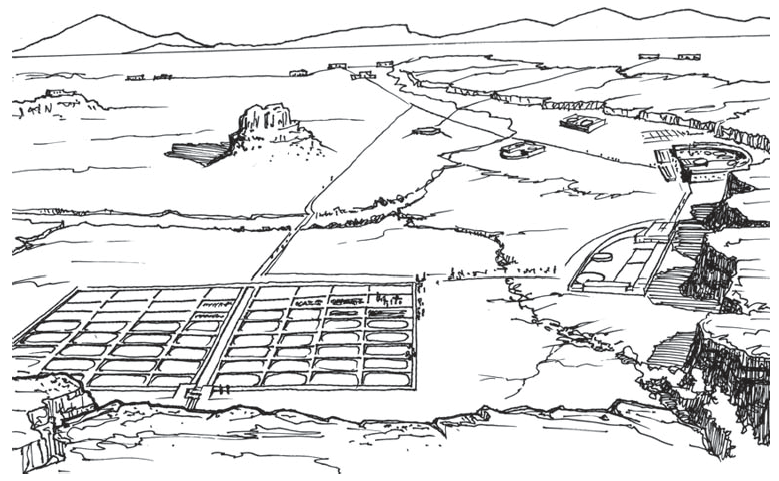
Shallow plastered
basins at Chaco Canyon are hugely miscalculated and incorrectly identified as
“grid gardens,”
as well as the Hohokam shallow plastered basins are
misidentified as “ball courts.”
The actual use of these basins was for
dehydrating blue green algae and other fertilizer additives such as night soil
and mesquite
duff.
Anasazi/Hohokam
The Chaco Anasazi New Mexico USA
A Cryptobiotic soil is a biological soil crust composed of living cyanobacteria, green algae, brown algae, fungi, lichens, and/or mosses. Commonly found in arid regions around the world, cryptobiotic soils go by many names, including cryptogamic, microbiotic, or microphytic soils or crusts. Soil crusts are important members of desert ecosystems and contribute to the well-being of other plants by stabilizing sand and dirt, promoting moisture retention, and fixing atmospheric nitrogen.
Because of their thin, fibrous nature, cryptobiotic soils are extremely fragile systems, a single footprint or tire track is sufficient to disrupt the soil crust and damage the organisms. While some species within the soil crust system may regrow within a few years of a disturbance, the damage to slow-growing species may require more than a century before the delicate soil returns to its former productivity.
At Chaco Canyon the Scarlet Macaw Clan of the Anasazi collected the run off from the cliffs immediately north of "Great Houses" and dehydrated the nitrate rich blue green algae particles in shallow plastered basins incorrectly identified as "grid gardens." We can know they were not gardens as they were plastered. The plastering allows the algae was allowed to grow or 'bloom" in the shallow catchments, other fertilizers were added such as human night soil, and the resulting mix was a very powerful fertilizer that was dried and then transported up to 60 miles or 100 km to the Chuska Mountains were the corn, beans and squash was actually grown.
The Salt River Hohokam Phoenix Valley Arizona
The Hohokam Canal System and Mesquite - The Hohokam canal system was probably built primarily for the cultivation of a mesquite bosque. It has been long questioned why the Hohokam built such an extensive system on one of the saltiest rivers in North America. Bean and especially corn cultivation is moderately to severely impacted by saline water and salinity. Mesquite is not impacted by levels of salinity found in the Salt River basin. My observation is that the Hohokam’s primary reason was to grow mesquite in the “delta” shaped canal system and mesquite conditioned the soil for corn and beans with nitrogen and shade temperature reduction, and moderated freeze sensitivity in the winter.
Prosopis L. Mesquite, as described by Franklin T. Bonner, scientist emeritus USDA Forest Service, is a tree which is “a hardy nitrogen-fixer. Mesquite legumes make high-quality forage for livestock and wildlife, and the seeds were widely used by Native American peoples in the Southwest (Davis and others 1975; Marting and Alexander 1974; Vines 1960). The crude protein contents of honey and velvet mesquite seeds are 31 and 24%, respectively (Becker and Grosjean 1980), and the legumes of honey mesquite are high in carbohydrates (Harden and Zolfaghari 1988).”
Professor Todd Bostwick said, “The Hohokam would have always faced the challenge of soil salinity, yet they farmed the same region for more than a thousand years, indicating that they understood how to deal with soil salinity — through the flushing of soils, leaving certain tracts fallow, alternating crop types planted, and other soil management techniques. Mesquite comprises approximately 50% of the archaeological record as compared to corn and beans.”
While I agree with Professor Bostwick, my observation indicates that, from the archaeological record, the canal system was built primarily to “grow mesquite” for food, firewood, and building materials. Worldwide, especially in very arid climates, trees are grown as an agricultural crop, and the Hohokam were doing the same.
Mesquite is a legume and as such it provides probably the “other” soil management technique used to add fertilizing soluble nitrates to the soils. When provided with adequate water, native mesquite produces a prolific supply of food, building material, and firewood. Mesquite is approximately 50 percent of the food product recovered from Hohokam sites (Todd Boswick).
In interviews, neither Professor Bostwick nor Howard indicated that the Hohokam used “grid gardens,” which have been proposed as the primary agricultural design during that time period elsewhere in Oasis America. I suggest that the Salt River mesquite delta across the Phoenix Valley also functioned in such a way as the salty water was used very little for corn and beans or perhaps not used at all. The primary parasite for corn is root cutworm and with very few hours below freezing each year, gardens in the Phoenix Valley could perhaps have only been used for a year or two maximum due to root cutworm infestations.
I propose that the strategy used by the Hohokam was to maintain an extensive mesquite forest watered by the canal system and that the gardens for corn and beans were moved throughout the “delta” season to season. Another factor to consider is that some of the canals are very deeply incised. This would have put the irrigation water well below any usable level for corn and beans, but would have been ideal to water the deep taproots of the mesquite.
The Hohokam also used shallow plastered dehydrated basins for making fertilizer from water, mesquite duff like leaves an pollen along with human night soil and other natural fertilizers, encourage a bloom of blue green algae and then dehydrating the mixture for efficiency of transport. These shallow plastered basins have incorrectly identified as "ball courts." Water polo anyone?
"Leguminous tree leaves generally have somewhere between 0.5% and 3% nitrogen, plus a similar amount of phosphorus and potassium. That doesn't sound like much, but when you consider how much biomass there is in the leaves of a tree, it can turn out to be nearly as much as most soils need."
Contributed by:
Roland Bunch
USA
For those who are interested in Conspiracy Theories from the internet:
"Our textbooks about soils emphasize much less than they should the value and potential of organic matter, which after all, kept the world's agriculture going very well until after World War II, when chemical fertilizer became cheaper. But I guess that is understandable: nearly every textbook out there published in English has at least one author who is or has been an employee of a chemical fertilizer company."
Egypt
Photography © Daniel Maddux

In ancient times the Nile River was the conveyer belt for the natural fertilizers produced in the Sudd Swamp
on the White Nile and to a much lesser degree the sediments produced by the Blue Nile from Ethiopia.
Visually the muddy Blue Nile waters when in flood are very impressive but it is actually the
nitrates from Sudd Swamp on the White Nile that produce the actual fertilizer that are the active ingredients of Nile's fertility.
The Sudd Swamp - A Natural Tropical Fertilizer Producer
I came to find the answer to this mystery of thousands of years via and expedition to the headwaters of the Blue Nile in Ethiopia.
In April 2002 I embarked on and expedition to Ethiopia, the home of Africa's deepest canyon, where I made a profound discovery that ultimately led to the knowledge of how Ancient Fertilizer built the pyramids of Egypt and ultimately the pyramid temples of the Angkor Empire of Cambodia. My Ethiopian guide and driver was a PhD of Agriculture. He related to me that as a grad student his team set out to find out exactly what was the fertility of the sediments of the Blue Nile. What they found that the sediments of the Blue Nile had absolutely Zero, yes, that is "0", zilch, would grow nothing, no fertility at all.
So if the sediments of the Nile River had no fertility where did the "fertility of the Nile that built the pyramids" actually come from? The answer to this conundrum eventually led to the discovery of what energy fueled the ancients to build their Monumental Architecture worldwide.
The Sudd, Sudan - It is the largest fresh water swamp in the world and is formed by river Nile in Southern Sudan on the African continent. The aquatic vegetation of Sudd is very thick and river gets divided into many smaller channels. About half of the Nile water entering the Sudd is either evaporated or absorbed before it leaves and moves further. It also restricts the travel across nice through it for centuries. The reason of this formation is that this land is almost totally flat and the water has no gully or slope to follow and therefore distributes.
The Sudd's aquatic vegetation consists mainly of reeds, grasses and water hyacinth. These channels keep changing with time so the boats have no fixed navigation path to follow and carry saws to clear if necessary. In year 1840 an Egyptian expedition was the first to cross the Sudd. Between 1899 and 2003 there were attempts to make a channel, even though it succeeded but required a constant maintenance to keep it open including a canal but the civil unrest in Sudan has kept such plans on hold. Water diversion in such a manner will also prove devastating for the rich aquatic life of the Sudd, on the other hand it would mean more water for North Sudan and Egypt. The Sudd is heaven for fish, hippos and many types of birds including unwanted mosquitoes. In the rainy season the Sudd can expand to an area the size of all of England
Africa Aquatic Nitrogen Fixing Plants
Rhizobia are the common bacterial symbionts that form nitrogen-fixing root nodules in legumes. However, recently other bacteria have been shown to nodulate and fix nitrogen symbiotically with these plants. Neptunia natans is an aquatic legume indigenous to tropical and subtropical regions and in African soils is nodulated by Allorhizobium undicola. This legume develops an unusual root-nodule symbiosis on floating stems in aquatic environments through a unique infection process.
Floating Aquatic Macrophytes
– Azolla
Floating aquatic macrophytes are defined as plants that float on the water surface, usually with submerged roots. Floating species are generally not dependent on soil or water depth.
Azolla spp. are heterosporous free-floating freshwater ferns that live symbiotically with Anabaena azollae, a nitrogen-fixing blue-green algae. These plants have been of particular interest to botanists and Asian agronomists because of their association with blue-green algae and their rapid growth in nitrogen deficient habitats (Islam and Haque, 1986). The genus Azolla includes six species distributed widely throughout temperate, sub-tropical and tropical regions of the world. It is not clear whether the symbiont is the same in the various Azollaspecies. They are found in East Africa and the Sudan.
Azolla spp. consists of a main stem growing at the surface of the water, with alternate leaves and adventitious roots at regular intervals along the stem. Secondary stems develop at the axil of certain leaves. Azolla fronds are triangular or polygonal and float on the water surface individually or in mats. At first glance, their gross appearance is little like what are conventionally thought of as ferns; indeed, one common name for them is duckweed ferns. Plant diameter ranges from 1/3 to 1 inch (1-2.5 cm) for small species like Azolla pinnata to 6 inches (15 cm) or more for A. nilotica (Ferentinos, Smith and Valenzuela, 2002).
(much of the above information from Wikipedia)
And what was the hauling power for the great stones? Easy. The Egyptians had oxen, which eat grass (not competing with humans for food), and plow fields during the planting season. Much stronger then human slaves and much more manageable. Oxen, not wind powered kites, five thousand slaves nor ancient aliens did most of the heavy lifting and hauling. It was also Oxen and elephants in the Khmer Civilization in Cambodia that hauled the millions of tones of stone. The human slavery and monumental architecture is a Roman idea in which western scientist are enthralled by even to this day. Even in Rome, however, oxen and horses probably did most of the heavy lifting and hauling.
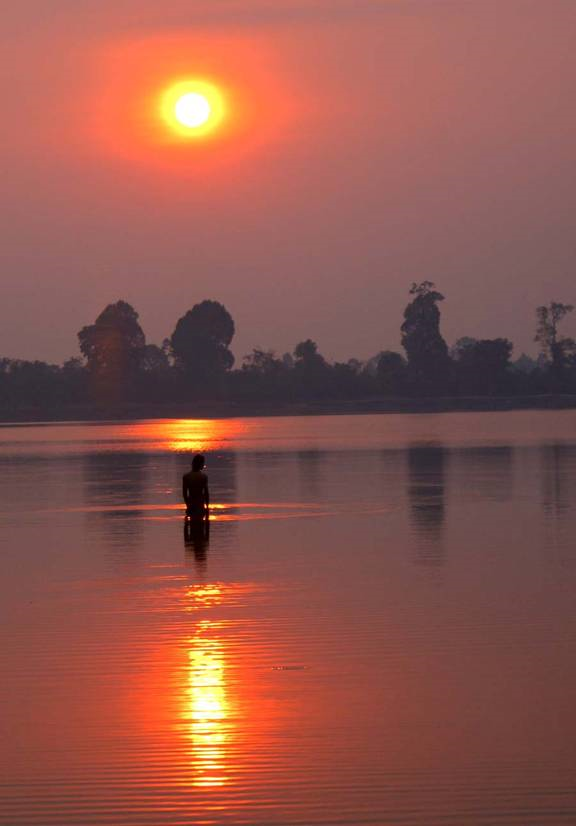
A new dawn for understanding ancient monuments at the East Baray. Angkor Cambodia February 2013
Not all Barays are created equal or for the same purpose. From interviews with the director of water resources for Angkor, I was informed that the North and East Barays may have been for the collection of drinking water. The real mystery at Angkor is the size, positioning, and use of the massive West Baray which is one of the largest known water collection basins in the ancient world. It is my proposal that the West Baray, as it is the outlet for all of the water collection at Angkor and all of the surrounding mountains, and is believed to provide the water directly to the rice fields, was for the purpose of collecting naturally produced nitrates of the forest with the addition of animal and human manures from the city and temples proper. This magnificent Baray grew perhaps hundreds of tons of blue green algae and aquatic water plants. Additionally, the West Baray could be drained during the dry season and all of these natural fertilizers compounded and enriched one upon the other, dehydrated and then transported to the extensive system of rice fields that supported not only the construction of the temples, but also the massive conquering armies of the Khmer Empire.
In an obvious leading question, were the barays in any way sealed and if so how and by what? If the West Baray was sealed, in any way, then it could early be a dehydrator of fertilizer as well.
After dehydration the fertilizer could be transported efficiently by ox cart and by water by the rivers and lake system even down the Mekong. If it was a fertilizer dehydrator the West Baray could have produced tones of super high quality fertilizer each year. This is a good idea for investigation by future archaeologist. A few simple core samples in each baray would do the trick.
I first must say THANK YOU to the Tarahumara Indians of the Copper Canyon, Mexico. When a British TV crew in the 1990's asked them "What is the most important thing in life" they replied "fertilizer." The TV crew found their response uproariously funny and no one but me paid attention. Because I paid attention I was able to, after a decade and a half of intensive research, find the critical keys to the scientific details contained in this web site. The Tarahumara are ultimately responsible for this scientific break through for ancient archaeology, history, human knowledge and modern science as well. Thank You to those anonymous Tarahumara Indians of the Sierra Madre of northern Mexico for sharing their ancient human knowledge.
Also, Thank you for so many short clips in this article to: Wikipedia, the free encyclopedia.
Without Wikipedia a massive research project such this could have never been accomplished.The internet is now the way forward for this type of scientific archaeological research project as there is a fundamental disconnect between the modern sciences of agriculture and archaeology and traditional educational channels have failed to provided this fundamental type of in-depth ancient knowledge to the modern student of archaeology.
For further research you can choose several key words from this web page and search them on the internet. There are several hundred web sites that are scientifically valid that disuse many of the issues raised here in detail. Of course many of the concepts presented here are original and there is a host of scientific yet to be discovered. Equally some of the key discoveries also can be combined in completely new ways to produce further scientifically valid insights. This is a brand new field to be studied by scholars. An entry level question. What should this new field of study be called?
Note from the Author:
I am well aware of fact that there are many spelling, grammar and design errors in this text and web page. Due to failing health at this time I wanted to get this 15 years of research out there before it was too late to finish it at all.
Anyone wishing to contribute time and effort, funds or more information and help perfect it, this assistance would be most welcome. Please contact me at: sunracer2@hotmail.com